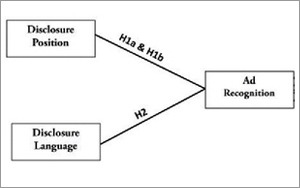 Consumers have difficulty distinguishing between native advertising and editorial content, according to a new study by researchers at Grady College in Georgia, published in the December issue of the Journal of
Advertising.
Consumers have difficulty distinguishing between native advertising and editorial content, according to a new study by researchers at Grady College in Georgia, published in the December issue of the Journal of
Advertising.
The study, titled “Going Native: Effects of Disclosure Position and Language on the Recognition and Evaluation of Online Native Advertising,” investigated how
consumers react to the size and placement of native ad disclosure statements in online news articles.
In the first experiment, the researchers asked subjects to read online content with two
stories, one editorial and one presenting native advertising. They displayed 12 different versions of the ad, with varying types of disclosure labels (“advertising,” “sponsored
by,” “brand voice,” and “presented by”), as well as different positions for the disclosure label including at the top, middle, and bottom of the page.
The
subjects were made to read the native ad first, followed by the real news story, then asked to distinguish which was which.
Overall, only 17 out of 242 subjects -- under 8% -- were able to
identify native advertising as a paid marketing message in this experiment. The experiment also revealed that consumers are seven times more likely to identify paid content as a native ad when it is
marked with terms like “advertising or “sponsored content” than if it carries terms like “brand voice” or “presented by.”
In the second experiment,
the researchers used eye-tracking technology to determine the most visible positions for placement of disclosure labels in articles. Here the researchers found that placement in the middle of the page
was more than twice as visible as placement at the top of the page, as 90% of subjects saw the former compared to just 40% of the latter.
Some 60% noticed the label at the bottom of the page.
But even when they noticed the disclosures, subjects didn’t necessarily make the connection. Just 18.3% identified native ads as paid messages in the second experiment.
These findings
should come as no surprise, considering that native advertising is intentionally presented in a format that resembles surrounding editorial content -- but they have particular relevance in light of
the Federal Trade Commission’s recent unveiling of new standards for native ads, intended to prevent advertisers from deceiving consumers.
Last week, the FTC released guidance warning that digital native ads that appear in news feeds of
publishers' sites, social media posts, search results and email potentially can be deceptive, unless advertisers clearly disclose that the ads are, in fact, ads. The new guidance directs companies to
label native ads that potentially could be mistaken for editorial content with terms like “advertisement,” “paid advertisement,” or “sponsored advertising
content.”
The FTC specifically criticized labels like “promoted” or “promoted stories,” stating that those terms “are at best ambiguous and potentially
could mislead consumers that advertising content is endorsed by a publisher site.”
The agency added that even terms like “promoted by,” followed by the name of the
advertiser, could be misinterpreted “to mean that a sponsoring advertiser funded or ‘underwrote’ but did not create or influence the content.”